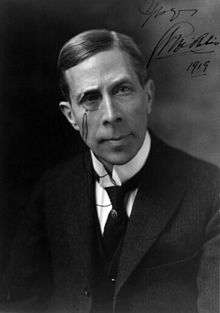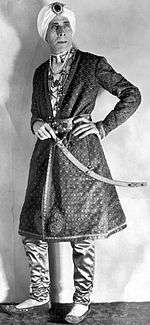George Arliss
George Arliss (born Augustus George Andrews, 10 April 1868 – 5 February 1946) was an English actor, author, playwright and filmmaker who found success in the United States. He was the first British actor to win an Academy Award – which he won for his performance as Victorian-era British prime minister Benjamin Disraeli in Disraeli (1929), as well as the earliest-born actor to win the honour.
George Arliss | |
|---|---|
 Arliss in 1919 | |
| Born | Augustus George Andrews 10 April 1868 London, England, UK |
| Died | 5 February 1946 (aged 77) London, England, UK |
| Occupation | Actor, author, playwright, filmmaker |
| Years active | 1887–1943 |
| Spouse(s) | Florence Kate Montgomery Smith (1899–1946) |
| Parent(s) | William Joseph Arliss Andrews |
Life and career
He was born in London and commonly listed as "George Augustus Andrews." His relatives referred to him as Uncle Gus. Arliss was educated at Harrow. He started work in the publishing office of his father (William Joseph Arliss Andrews) but left at age 18 to go on the stage. He began his acting career on the stage in the British provinces in 1887. By 1900, he was playing London's West End in supporting roles. He embarked for a tour of America in 1901 in Mrs. Patrick Campbell's troupe, intending to remain in the United States only for the length of the tour. Arliss stayed for twenty years, making his Broadway debut in Magda (1902).[1] He eventually became a star in 1908 in The Devil. Producer George Tyler commissioned Louis Napoleon Parker in 1911 to write a play specifically tailored for Arliss, and the actor toured in Disraeli for five years, eventually becoming closely identified with the 19th century British prime minister.
He began his film career with The Devil (1921), followed by Disraeli and four other silent films. Today, only The Devil, Disraeli, $20 a Week, and The Green Goddess (1923), based on the hit stage play in which he had starred, are known to have survived. He remade both The Green Goddess and Disraeli in sound in 1929 (and won the Best Actor Academy Award for Disraeli), converting successfully at the age of 61 from a star of the legitimate theatre, and then silent films, to sound films.
Arliss made 10 sound films exclusively for Warner Bros. under a contract that gave the star an unusual amount of creative control for the time. Curiously, his casting of actors and rewriting of scripts were privileges granted him by the studio that are not even mentioned in his contract. One of these films, The Man Who Played God (1932), was Bette Davis's first leading role. Until the end of Davis's life, she credited Arliss for personally insisting upon her as his leading lady and giving her a chance to show her abilities. The two also co-starred in The Working Man in 1933.

Arliss built a production unit at Warners' both in front of and behind the cameras. Maude T. Howell, his stage manager, became an assistant producer and was one of the few female film executives in Hollywood at that time. After his first three films, Arliss approved John Adolfi, a capable Warners director who was open to collaboration with him, to direct each of his films. Adolfi soon was regarded as a successful director of the critically and financially acclaimed Arliss films. Arliss preferred to use the same reliable actors, such as Ivan Simpson (who was also a sculptor) and Charles Evans, from film to film. Arliss had an eye for discovering unknown talent, such as James Cagney, Randolph Scott and Dick Powell. Despite his extensive involvement in the planning and production of his films, Arliss claimed credit only for acting.
Working closely with Warners' production chief, Darryl F. Zanuck, Arliss left the studio when Zanuck resigned in April 1933. (Arliss's trusted director John Adolfi also died suddenly in early May.) Zanuck quickly signed Arliss to make new films at Zanuck's fledgling studio, 20th Century Pictures, prompting Warners' to complain to the Motion Picture Academy of Arts and Sciences that Zanuck had "stolen" their star. Arliss is remembered primarily for his witty series of historical biopics, such as Alexander Hamilton, Voltaire, The House of Rothschild, The Iron Duke, and Cardinal Richelieu.
However, he also had a series of domestic comedies such as The Millionaire, A Successful Calamity, The Working Man, and The Last Gentleman.

He often appeared with his wife Florence Arliss (née Florence Kate Montgomery Smith) (1871–1950), to whom he was married from 16 September 1899 until his death. (Leslie Arliss, who became a prolific producer-director for Gainsborough Pictures, is erroneously referred to as their son in some reference works.) Florence (or "Flo", as George called her) starred both on stage and in films, both silent and sound, with her husband and almost always played his character's spouse. However, that did not prevent Arliss from using another actress when Flo was not right for a role. Also, Flo turned down roles that George wanted her to play in some films.
In 1934 British film goers named Arliss their favourite male star.[2]
Arliss was approaching 70 when he completed the British-made Doctor Syn in 1937. He and Flo returned to America later that year to visit old friends, including famed astronomer Edwin Hubble in California. Producer-director Cecil B. DeMille arranged for the Arlisses to re-enact their roles in Disraeli on Lux Radio Theatre, DeMille's popular radio show, in January 1938. The occasion was heralded as "a new page in radio history". George and Flo subsequently appeared on Lux in radio adaptations of The Man Who Played God in March 1938 and in Cardinal Richelieu in January 1939, which was apparently their final dramatic appearance anywhere. Returning to their home in London in April 1939, the onset of the Second World War prevented their return to America during Arliss's remaining years. The only taint of scandal involved charges by the British Government in September 1941 that Arliss had not complied with a recent requirement to report bank accounts he maintained in the U.S. and Canada (similar charges were also brought against actor-playwright Noël Coward around the same time). Both men claimed ignorance of the new law, but they were fined and publicly humiliated by the experience.
Last years and death
Arliss settled at Pangbourne in Berkshire. Film producer Darryl F. Zanuck tried to interest Arliss in returning to Hollywood to star in The Pied Piper in 1942. Braving the Luftwaffe's Blitz on London throughout the war, Arliss remained in his native city. He died in Maida Hill in London of a bronchial ailment on 5 February 1946, aged 77.[3] His gravestone does not refer to his success in the performing arts, although it does cite the one achievement of which he was apparently most proud: an honorary Master of Arts degree he received from Columbia University in 1919.
Book
In 1927, Arliss's autobiography Up the Years from Bloomsbury was published.[4]
Other
Arliss was a prominent anti-vivisectionist who founded the National Anti-Vivisection Society of Chicago. He was president of the Episcopal Actors' Guild of America from 1921 to 1938.[5]
He was a strict vegetarian, stating that "I eat nothing I can pat".[6] Arliss walked four miles each day and took interest in aerobics.[6]
Recognition
Arliss has a star on the Hollywood Walk of Fame at 6648-1/2 Hollywood Boulevard.[7] He is also a member of the American Theater Hall of Fame.[8] His grave is located in London's All Saints' Churchyard, Harrow Weald.
Filmography
| Year | Title | Role | Notes |
|---|---|---|---|
| 1921 | The Devil | Dr. Muller | |
| 1921 | Disraeli | Benjamin Disraeli | |
| 1922 | The Man Who Played God | Montgomery Royle | |
| 1922 | The Ruling Passion | James Alden | |
| 1922 | The Starland Review | Himself | archive |
| 1923 | The Green Goddess | Rajah of Rukh | |
| 1924 | Twenty Dollars a Week | John Reeves | |
| 1929 | Disraeli | Benjamin Disraeli | Academy Award for Best Actor |
| 1930 | The Green Goddess | Raja of Rukh | Nominated — Academy Award for Best Actor |
| 1930 | Old English | Sylvanus Heythorp | |
| 1931 | Alexander Hamilton | Alexander Hamilton | |
| 1931 | The Millionaire | James Alden | |
| 1932 | A Successful Calamity | Henry Wilton | |
| 1932 | The Man Who Played God | Montgomery Royle | Released as The Silent Voice in the United Kingdom |
| 1933 | Voltaire | Voltaire | |
| 1933 | The Working Man | John Reeves | |
| 1933 | The King's Vacation | Phillip, the King | |
| 1934 | The Iron Duke | Duke of Wellington | |
| 1934 | The Last Gentleman | Cabot Barr | |
| 1934 | The House of Rothschild | Mayer Rothschild / Nathan Rothschild | Finale filmed in Technicolor |
| 1935 | The Tunnel | Prime Minister of the United Kingdom | Released as Transatlantic Tunnel in the United States |
| 1935 | Cardinal Richelieu | Cardinal Richelieu | |
| 1935 | The Guv'nor | The Guv'nor | Released as Mister Hobo in the United States |
| 1936 | His Lordship | Richard Fraser/Lorimer, Lord Duncaster | Released as Man of Affairs in the United States |
| 1936 | East Meets West | Sultan of Rungay | |
| 1937 | Doctor Syn | Dr. Syn | |
| 1939 | Land of Liberty | archive footage | |
| 1943 | The Voice That Thrilled the World | Himself | segment Disraeli – archive footage, uncredited |
See also
References
- Notes
- "("George Arliss" search results)". Internet Broadway Database. The Broadway League. Retrieved 13 July 2019.
- "FILM WORLD". The West Australian. Perth: National Library of Australia. 1 February 1935. p. 2. Retrieved 4 March 2013.
- "Mr. George Arliss". The Times. Longon, England. 6 February 1946. p. 7.
- Allison, W. T. (29 October 1927). "Up the Years from Bloomsbury With George Arliss". Times Colonist. Canada, British Columbia, Victoria. p. 26. Retrieved 13 July 2019 – via Newspapers.com.
- Starr, Kevin (28 November 2002). "The Dream Endures: California Enters the 1940s". Oxford University Press – via Google Books.
- Fells, Robert M. (2004). George Arliss: The Man who Played God. The Scarecrow Press. p. 5. ISBN 0-8108-5160-1
- "George Arliss". Hollywood Walk of Fame. Archived from the original on 5 November 2013. Retrieved 13 July 2019.
- "Members". Theatre Hall of Fame. Archived from the original on 15 April 2013. Retrieved 13 July 2019.
- Bibliography
- Fells, Robert M. George Arliss: The Man Who Played God (Scarecrow Press, 2004)
- Fells, The Arliss Archives: The Further Adventures of the Man Who Played God (Arliss Publishing House, 2011)
- Fells, More Rarities From the Arliss Archives: A 125th Anniversary Salute to George Arliss (Arliss Publishing House, 2012)
- Fells, The 1921 Lost DISRAELI: A Photo Reconstruction of the George Arliss Silent Film (Arliss Publishing House, 2013)
- Arliss, George. Up the Years from Bloomsbury (1927)
- Arliss, George. My Ten Years in the Studios (George Arliss by Himself in UK) (1940)
External links
| Wikimedia Commons has media related to George Arliss. |
- George Arliss on IMDb
- George Arliss at the Internet Broadway Database

- Photographs and literature
- Arliss archives @ wordpress.com
- George Arliss collection(Univ. of Washington, Sayre)